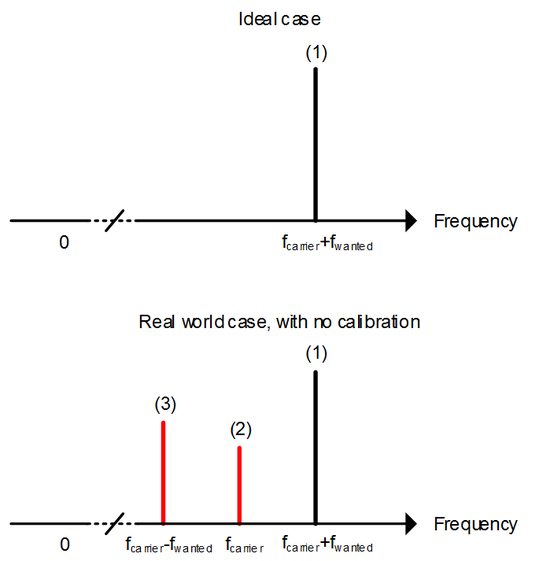LMS7002Mr3 Calibration Using MCU: Difference between revisions
No edit summary |
No edit summary |
||
| Line 19: | Line 19: | ||
* '''IQ Image''' (3) – unwanted TX sideband, with an offset -f<sub>wanted</sub> from the carrier frequency f<sub>carier</sub>. Primary caused by gain and phase imbalances in different IQ signal blocks. | * '''IQ Image''' (3) – unwanted TX sideband, with an offset -f<sub>wanted</sub> from the carrier frequency f<sub>carier</sub>. Primary caused by gain and phase imbalances in different IQ signal blocks. | ||
[[File:LMS7002Mr3Cal_TX_spectral_tones.png|center|550px|Figure 1. TX spectral tones looking at the TX output. Here: (1) – TX Wanted Signal; (2) – TX LO Leakage; (3) – TX IQ Image.]] | [[File:LMS7002Mr3Cal_TX_spectral_tones.png|center|550px|Frame|Figure 1. TX spectral tones looking at the TX output. Here: (1) – TX Wanted Signal; (2) – TX LO Leakage; (3) – TX IQ Image.]] | ||
Revision as of 11:54, 13 July 2017
Introduction
This document provides a brief description of the main calibration procedures used to improve the RF performance of LMS7002M IC by using the built-in microcontroller (MCU). It also contains information needed to program and run LMS7002M IC internal MCU, which handles the calibration procedure execution routines, thus greatly simplifying the calibration porting procedure to other systems.
General MCU calibration description
This section focuses on a brief description of the calibration procedures themselves that are handled by the program stored in MCU image. The calibration procedures for the LMS7002M chip are listed below:
- DC offset and LO Leakage, and Quadrature (IQ) chain imbalance calibration;
- Analog filter -3 dB bandwidth calibration.
Calibration procedures are used for both transmitter (TX) and receiver (RX) chains, although the individual calibration setup and flow is different for each of them.
For the ideal TX case, if the continuous wave (CW) signal is up-converted to radio frequency (RF), the TX output ideal spectrum has no unwanted components, as showed in Figure 1 upper graph. In non-linear conditions, the TX output spectrum has unwanted tones as shown in Figure 1 lower graph. Descriptions of the tones are given below:
- Wanted Signal (1) – wanted TX sideband, with an offset fwanted from the carrier frequency fcarier;
- LO Leakage (2) – primarily caused by DC offsets in the TX baseband and LO leakage at the TX frequency mixing stage;
- IQ Image (3) – unwanted TX sideband, with an offset -fwanted from the carrier frequency fcarier. Primary caused by gain and phase imbalances in different IQ signal blocks.
